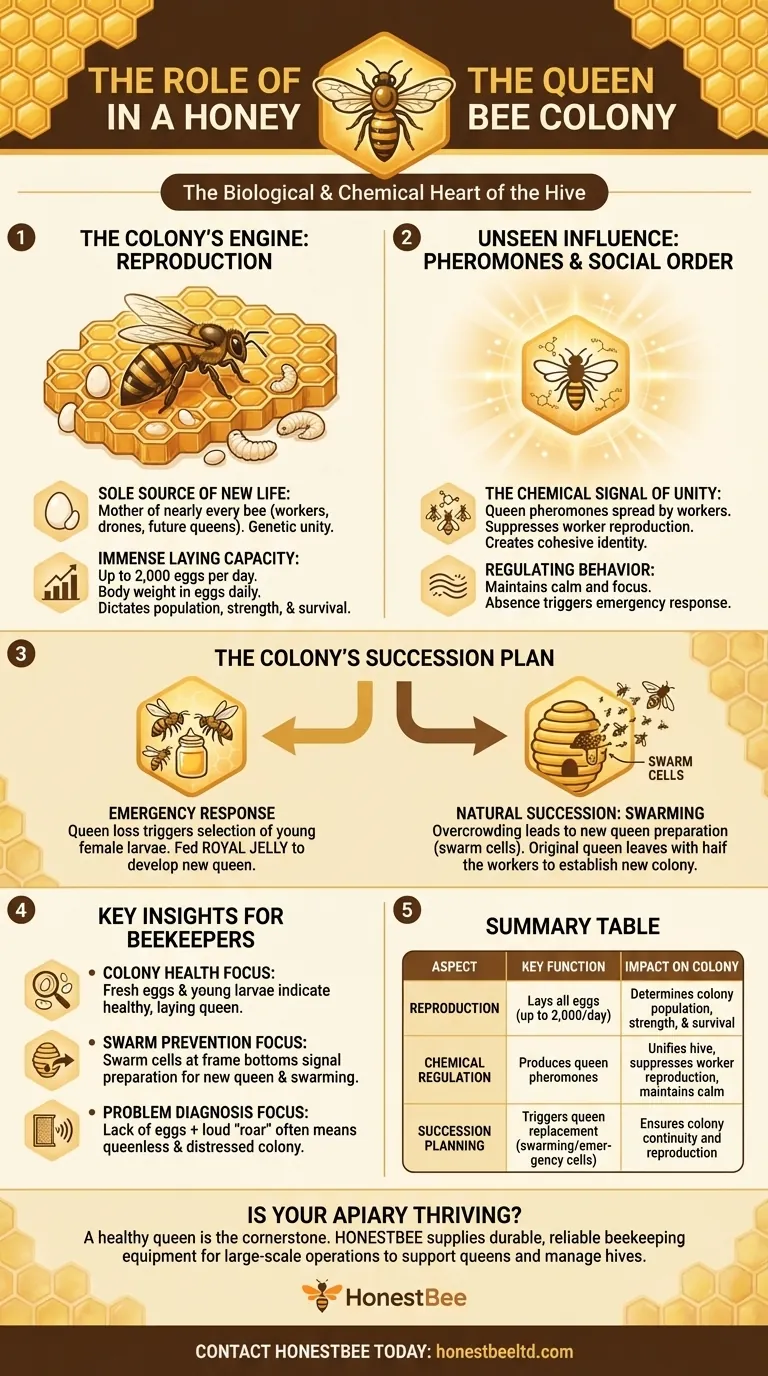The primary role of the queen bee is twofold: she is the sole reproductive individual responsible for laying all the eggs in a colony, and she produces chemical signals called pheromones that unify the hive and regulate the behavior of all other bees. Her presence and health are the central organizing principle of the entire colony.
The queen should not be thought of as a ruler giving commands, but rather as the biological and chemical heart of the hive. Her function is not to govern, but to ensure the colony's continuity through reproduction and social cohesion.

The Queen as the Colony's Engine: Reproduction
The queen's most visible and vital function is her role as the mother of the colony. Her ability to lay eggs dictates the hive's population, strength, and survival.
The Sole Source of New Life
A healthy queen is the mother of nearly every bee in her hive—the workers, the drones, and any future queens. This genetic unity is fundamental to the cooperative nature of the colony.
Immense Laying Capacity
During peak season, a productive queen can lay over 2,000 eggs per day. Her body weight in eggs can exceed her own body weight each day, making her a true reproductive engine.
The Unseen Influence: Pheromones and Social Order
While egg-laying is her physical contribution, the queen's chemical influence is just as critical. She constantly emits a unique blend of pheromones that serve as the "social glue" for the colony.
The Chemical Signal of Unity
The queen's pheromones, spread throughout the hive by worker bees, signal her presence and health. This chemical message suppresses the reproductive systems of worker bees, ensuring she remains the only egg-layer, and creates a cohesive colony identity.
Regulating Colony Behavior
The presence of these pheromones keeps the colony calm and focused. The absence of this signal, due to the queen's death or departure, is immediately noticed and triggers an emergency response from the workers.
The Colony's Succession Plan
A honey bee colony cannot survive for long without a laying queen. Because of this, the bees have sophisticated, built-in mechanisms to replace her when necessary.
The Emergency Response
If a queen is suddenly lost, dies, or begins to fail, the worker bees will select several of the youngest female larvae already present in the hive. By feeding these specific larvae a diet exclusively of royal jelly, they can develop one of them into a new queen.
Natural Succession: Swarming
Swarming is the colony's natural method of reproduction. When a hive becomes overcrowded, the workers will prepare to raise a new queen in special wax structures called swarm cells. The original queen then leaves the hive with about half the worker bees to establish a new colony elsewhere, leaving the old hive to the new queen.
The Beekeeper's Role
Understanding this cycle is crucial for beekeepers. Management techniques like the Pagden artificial swarm or creating a nucleus colony are designed to control the swarming impulse by manipulating the presence of the queen and allowing the beekeeper to manage colony growth.
Key Insights for Beekeepers and Observers
Understanding the queen's status provides a direct window into the health and future plans of the entire colony.
- If your primary focus is colony health: The presence of fresh eggs and young larvae is the most reliable sign you have a healthy, laying queen, even if you cannot see her directly.
- If your primary focus is swarm prevention: The appearance of swarm cells along the bottom of frames is a clear indicator that the colony is preparing to raise a new queen and will likely swarm soon.
- If your primary focus is diagnosing a problem: A lack of eggs combined with an unusually loud "roar" from the hive often indicates the colony is queenless and in a state of distress.
Ultimately, understanding the queen's central role is the key to understanding the honey bee colony as a whole.
Summary Table:
| Aspect of Queen's Role | Key Function | Impact on Colony |
|---|---|---|
| Reproduction | Lays all eggs (up to 2,000/day) | Determines colony population, strength, and survival |
| Chemical Regulation | Produces queen pheromones | Unifies the hive, suppresses worker reproduction, maintains calm |
| Succession Planning | Triggers queen replacement (swarming/emergency cells) | Ensures colony continuity and reproduction |
Is Your Apiary Thriving?
A healthy, productive queen is the cornerstone of every successful colony. For commercial apiaries and distributors, managing queen health and colony dynamics is critical for maximizing honey production and ensuring strong, overwintering hives.
HONESTBEE supplies the durable, reliable beekeeping supplies and equipment you need to support your queens and manage your hives effectively. From hive tools to protective gear, we provide the wholesale-focused solutions for large-scale operations.
Contact HONESTBEE today to discuss how our equipment can help you build a stronger, more productive apiary.
Visual Guide

Related Products
- High Performance Plastic Queen Excluder for Beekeeping and Apiary Management
- HONESTBEE Anatomy Bee Model Detailed Anatomical Display for Education and Study
- Wooden Queen Bee Excluder for Beekeeping
- Premium Wood Framed Metal Wire Queen Bee Excluder
- Metal Queen Bee Excluder for Beekeeping
People Also Ask
- Why don't all beekeepers use Queen Excluders? Balancing Honey Purity with Hive Productivity
- What materials are modern queen excluders made from? Choose the Right Material for Your Apiary
- When is the best time to place a queen excluder? Optimize Honey Production & Purity
- What are the benefits of a queen excluder? Ensure Pure Honey & Simplify Hive Management
- What impact does a queen excluder have on colony defensiveness? Control Hive Temperament for Safer Beekeeping



















